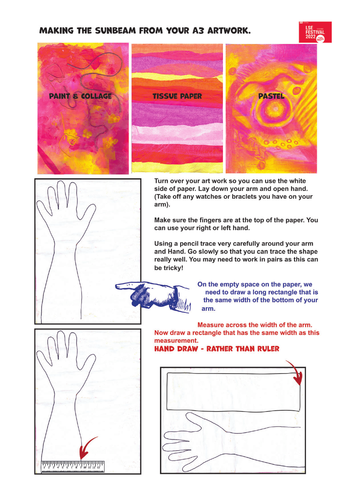








A brief history of the history of childhood, or how children were valued, from the 1800s to now, explains the concept of rights and human rights, looks at why the Declaration in 1924 and the Convention in 1989 was made and the impact of them. The last lesson brings Children’s Rights to date with new articles that have been ratified by the United Nations on children’s digital rights and covers security and good practice online.
These lessons ask how did a message of hope for children come out of war, disease and famine? What can we learn from this? Can we do something similar after the COVID-19 pandemic? What do children think they and we (as adults, communities, schools, families etc) should do to create a happier future for them? The activities at the end of the lesson can be used to lead into an art project in which students make their raised arm and hand a sunbeam and write on it their hopes for the future. These can be put together collectively as a class.
The project is based on the principles of the Recovery Curriculum, which stresses mental wellness, and is designed to give students their own agency. It aims to help children develop their voice and express themselves through words and art.
It is for Upper Key Stage 2 (years 5/6) but could be adapted for Key Stage 3 Year 7/8.
Lessons:
One – Protecting Children
Two – Saving Children
Three – Declaring Children’s Rights
Four – Children’s Rights in a Digital World
Five – Declaring Your Rights (Art / Writing Activity)
Curriculum Links:
• History – Great People, Topic after 1066 – World War One and aftermath
• Citizenship / British Values – Children’s Rights, Tolerance, International Relations
• Art and Design – understanding symbols, imagery in art, new techniques
• Literacy and Writing – understanding and writing demands, using and writing poetry
• ICT – Understanding the possibilities of collaboration and awareness of safety online.
• RSE – Mental wellbeing, understanding range of emotions and managing relationships / activities online.
Learning Outcomes:
• An understanding of Eglantyne Jebb, Dorothy Buxton, their work and their shared childhood
• An understanding of how ideas around protecting and valuing children have changed.
• The ability to discuss the concept of rights and consider how a concept is put into practice.
• To listen to each other respectfully, express feelings and to share ideas.
• Understanding and being able to recognise rights for children.
• To understand the image and use of Sunbeams – what it means visually in art, nature etc.
Something went wrong, please try again later.
This resource hasn't been reviewed yet
To ensure quality for our reviews, only customers who have downloaded this resource can review it
Report this resourceto let us know if it violates our terms and conditions.
Our customer service team will review your report and will be in touch.